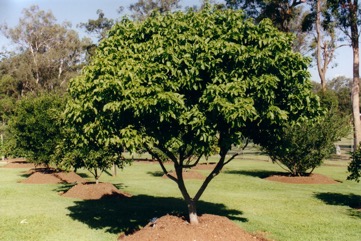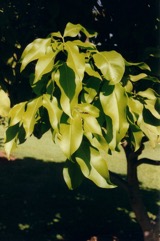Spanish lime, Mamoncillo, Genip

A tropical plant. It suits the hot tropical lowlands. It is native to tropical America. It grows up to 1,000 m above sea level in tropical America. It is sensitive to cold. Plants are damaged by temperatures near freezing. It can grow on a range of soils. It is more common in dry areas. It is resistant to drought. It can weather strong tropical storms. It cannot tolerate frost. In Brisbane Botanical Gardens.
Also known as:
Genipe, Ginep, Ginip, Grosella de miel, Guayo, Guenepa, Guinep, Honey-berry, Kanappy, Kenep, Kinep, Knippa, Limoncillo, Mamon, Mamoncillo, Pitomba-das-guianas, Quenep
Synonyms
- Melicocca bijuga L.
- Melicoccus bijuga L.
- Melicoccus carpopodea Juss.
- Schinus melicoccus L.
Edible Portion
- Fruit, Seeds, Kernel
Where does Spanish lime grow?
Found in: Africa, Amazon, Antigua and Barbuda, Aruba, Asia, Australia, Bahamas, Barbados, Belize, Brazil, Burkina Faso, Cameroon, Caribbean, Central Africa, Central America, Colombia, Cook Islands, Costa Rica, Cuba, Dominican Republic, El Salvador, French Guiana, Ghana, Grenada, Guianas, Guyana, Haiti, Hawaii, Hispaniola, Jamaica, Marquesas, Mexico, Nicaragua, North America, Pacific, Panama, Philippines, Puerto Rico, SE Asia, Senegal, Singapore, South America, St. Kitts and Nevis, Suriname, Trinidad & Tobago, United States, Venezuela, West Africa, West Indies
Notes: There are 2 Melicoccus species.
Status: They are sold in markets. It is a cultivated plant.
Growing Spanish lime, Mamoncillo, Genip
Cultivation: Plants are grown from seed. The plants vary in quality and yield. Better varieties are air-layered or grafted.
Edible Uses: The fruit is eaten fresh. It is also made into drinks and cooked. They are used in pies, jams, jellies, marmalades and drinks. The seeds are roasted and eaten. CAUTION: Because of the size of the fruit and the fact that they are very slippery, care should be taken that they are not swallowed and block the wind pipe of children.
Production: Trees develop slowly. They take 7-10 years to produce fruit from seed. They can take 4-5 years to fruit from layers. The fruit take 90-150 days to mature. They store and transport well.
Nutrition Info
per 100g edible portion| Edible Part | Energy (kcal) | Protein (g) | Iron (mg) | Vitamin A (ug) | Vitamin c (mg) | Zinc (mg) | % Water |
|---|---|---|---|---|---|---|---|
| Fruit | 59 | 0.8 | 0.6 | 25 | 5 | - | 78.4 |
Spanish lime, Mamoncillo, Genip Photos


References
Abbiw, D.K., 1990, Useful Plants of Ghana. West African uses of wild and cultivated plants. Intermediate Technology Publications and the Royal Botanic Gardens, Kew. p 46
Barrau, J., 1961 (1976 reprint), Subsistence Agriculture in Polynesia and Micronesia. Bernice P. Bishop Museum Bulletin 223, Honolulu, Hawaii, p 63
Barwick, M., 2004, Tropical and Subtropical Trees. A Worldwide Encyclopedic Guide. Thames and Hudson p 272
Burkill, H. M., 1985, The useful plants of west tropical Africa, Vol. 5. Kew.
Burkill, I.H., 1966, A Dictionary of the Economic Products of the Malay Peninsula. Ministry of Agriculture and Cooperatives, Kuala Lumpur, Malaysia. Vol 2 (I-Z) p 1469
Bystrom, L. M., 2012, The Potential Health Effects of Melicoccus bijugatus Jacq. Fruits: Phytochemical, Chemotaxonomic and Ethnobotanical Investigations. Fitoterapia, 83(2), pp. 266–270.
Coe, F. G., and Anderson, G. J., 1996, Ethnobotany of the Garifuna of Eastern Nicaragua. Economic Botany 50(1) pp 71-107
Coe, F. G. and Anderson, G. J., 1999, Ethnobotany of the Sumu (Ulwa) of Southeastern Nicaragua and Comparisons with Miskitu Plant Lore. Economic Botany Vol. 53. No. 4. pp. 363-386
Coronel, R.E., 1982, Fruit Collections in the Philippines. IBPGR Newsletter p 7, 10 (As Melicocca bijuga)
Enum. syst. pl. 19. 1760 (Select. stirp. amer. hist. 108, t. 72. 1763)
Facciola, S., 1998, Cornucopia 2: a Source Book of Edible Plants. Kampong Publications, p 225
Food Composition Tables for use in East Asia FAO http://www.fao.org/infoods/directory No. 858
Francis, J. K., 1992, Melicoccus bijugatus Jacq. Quenepa - Sapindaceae - Soapberry family, USDA Forest Service, International Institute of Tropical Forestry.
Grandtner, M. M., 2008, World Dictionary of Trees. Wood and Forest Science Department. Laval University, Quebec, Qc Canada. (Internet database http://www.wdt.qc.ca)
Grandtner, M. M. & Chevrette, J., 2013, Dictionary of Trees, Volume 2: South America: Nomenclature, Taxonomy and Ecology. Academic Press p 390
Hedrick, U.P., 1919, (Ed.), Sturtevant's edible plants of the world. p 408 (As Melicocca bijuga)
Hermandez Bermejo, J.E., and Leon, J. (Eds.), 1994, Neglected Crops. 1492 from a different perspective. FAO Plant Production and Protection Series No 26. FAO, Rome. p17
Jardin, C., 1970, List of Foods Used In Africa, FAO Nutrition Information Document Series No 2.p 147
John, L., & Stevenson, V., 1979, The Complete Book of Fruit. Angus & Robertson p 291
Kiple, K.F. & Ornelas, K.C., (eds), 2000, The Cambridge World History of Food. CUP p 1856
Kubitzki, K., (Ed.), 2011, The Families and Genera of Vascular Plants. Vol. 10, Springer. p 383
Lorenzi, H., Bacher, L., Lacerda, M. & Sartori, S., 2006, Brazilian Fruits & Cultivated Exotics. Sao Paulo, Instituto Plantarum de Estuados da Flora Ltda. p 613
Macmillan, H.F. (Revised Barlow, H.S., et al) 1991, Tropical Planting and Gardening. Sixth edition. Malayan Nature Society. Kuala Lumpur. p 303
Martin, F. W., et al, 1987, Perennial Edible Fruits of the Tropics. USDA Handbook 642 p 57
Melander, M., 2007, Endangered plants on the market in Havana City, Cuba. Uppsala University, Sweden p 19 (As Melicocca bijuga)
Menninger, E.A., 1977, Edible Nuts of the World. Horticultural Books. Florida p 70
Miguel, E., et al, 1989, A checklist of the cultivated plants of Cuba. Kulturpflanze 37. 1989, 211-357
Morton, J. F., 1987, Fruits of Warm Climates. Wipf & Stock Publishers p 267
NYBG Herbarium "edible"
Omawale, 1973, Guyana's edible plants. Guyana University, Georgetown p 18
Paz, F. S., et al, 2021, Edible Fruit Plant Species in the Amazon Forest Rely Mostly on Bees and Beetles as Pollinators. Journal of Economic Entomology, XX(XX), 2021, 1–13
Plants of Haiti Smithsonian Institute http://botany.si.edu/antilles/West Indies
Popenoe,
Ricker, M., et al, 1997, The Case for Borojoa patinoi (Rubiaceae) in the Choco Region, Colombia. Economic Botany 51(1) pp 39-48
Segura, S., et al, 2018, The edible fruit species in Mexico. Genet Resour Crop Evol (2018) 65:1767–1793
Staples, G.W. and Herbst, D.R., 2005, A tropical Garden Flora. Bishop Museum Press, Honolulu, Hawaii. p 516
Tankard, G., 1990, Tropical fruit. An Australian Guide to Growing and using exotic fruit. Viking p 111
Timyan, J., 1996, Bwa Yo: Important Trees of Haiti. SE Consortium for International Development. Washington. p 217
USDA, ARS, National Genetic Resources Program. Germplasm Resources Information Network - (GRIN). [Online Database] National Germplasm Resources Laboratory, Beltsville, Maryland. Available: www.ars-grin.gov/cgi-bin/npgs/html/econ.pl (10 April 2000)
Wickens, G.E., 1995, Edible Nuts. FAO Non-wood forest products. FAO, Rome. p150
http://cookislands.bishopmuseum.org
World Checklist of Useful Plant Species 2020. Royal Botanic Gardens, Kew